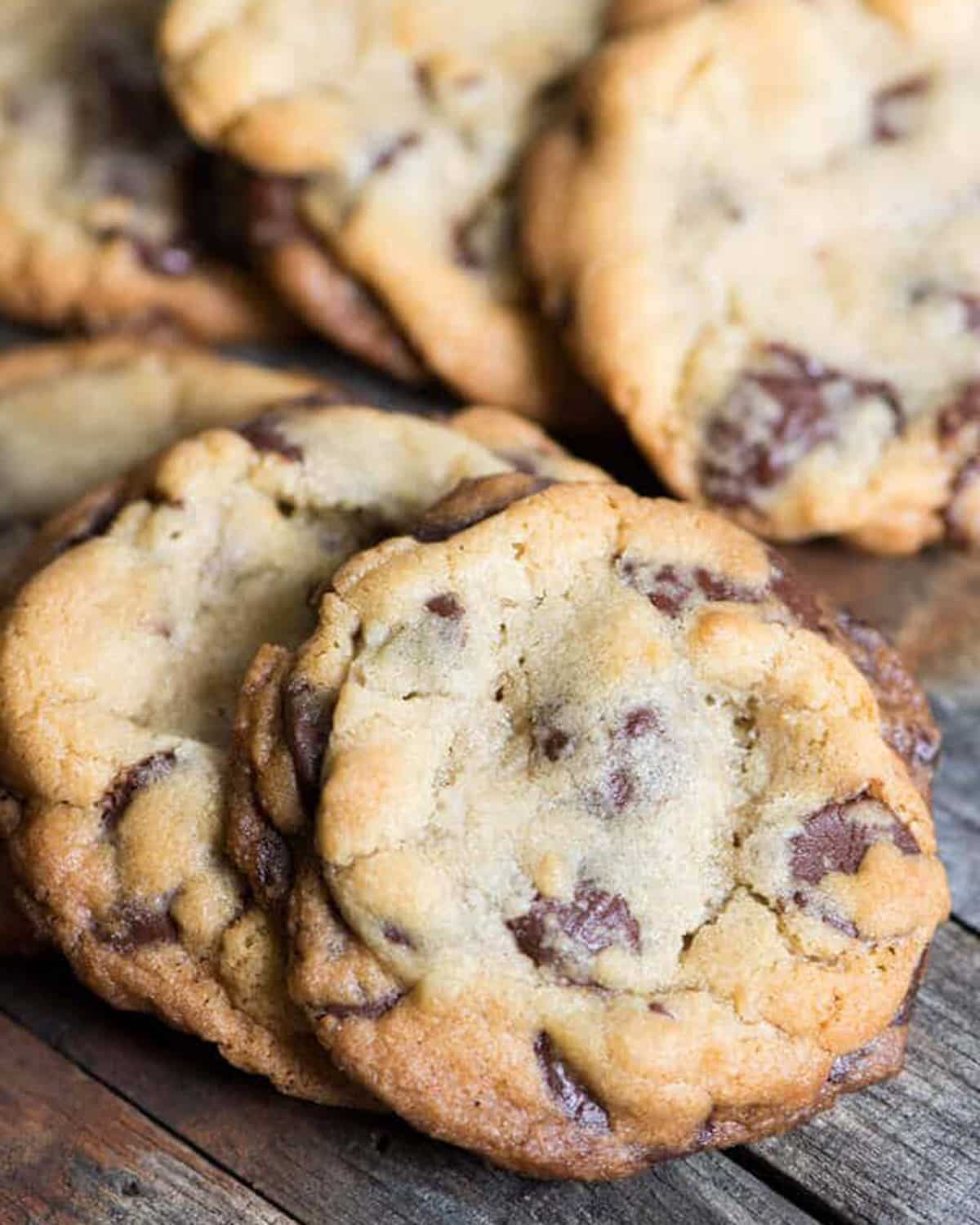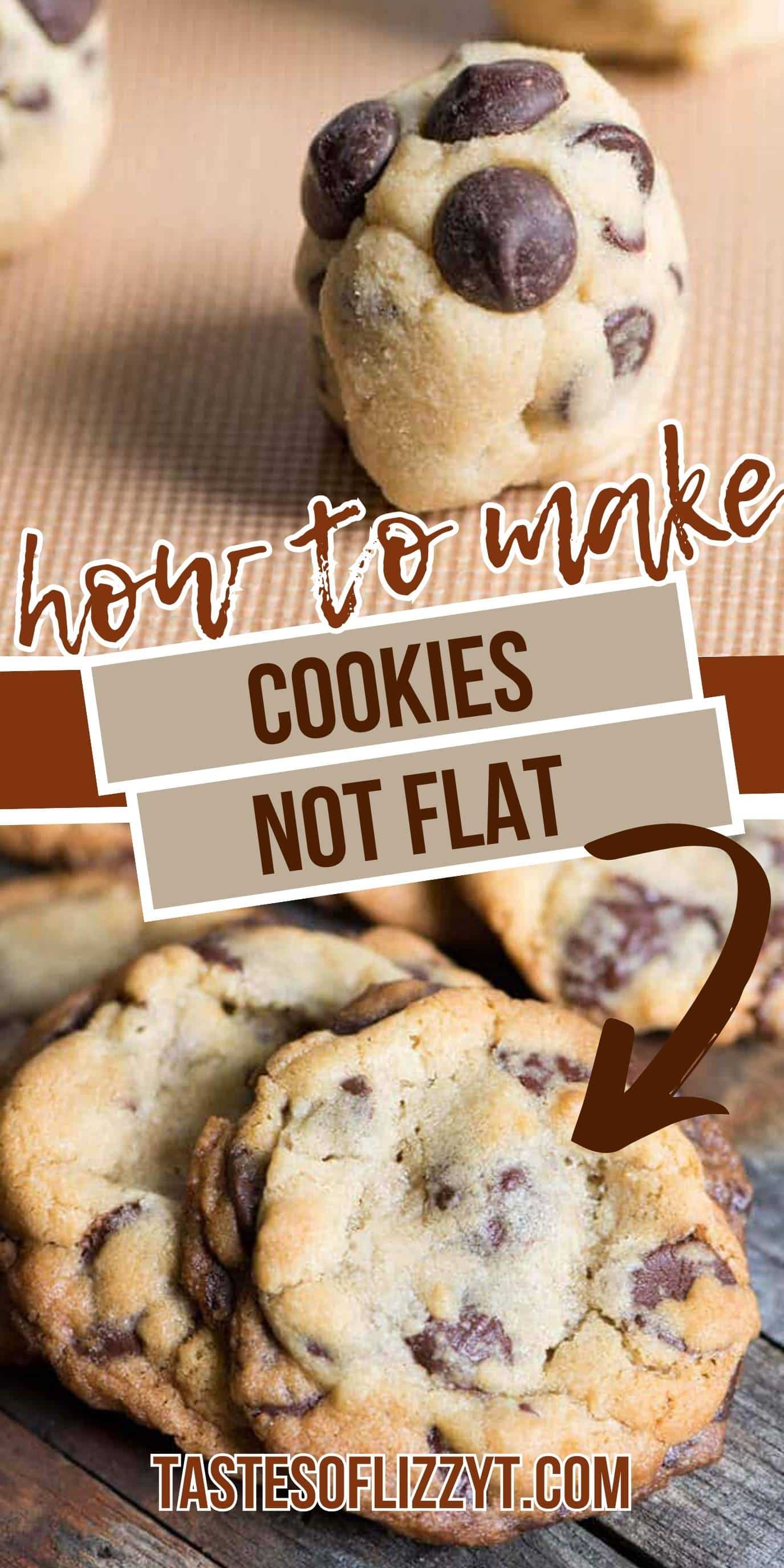Why Are My Cookies Flat?
May contain affiliate links. Disclosure policy.
If you’ve ever asked, “Why are My Cookies Flat?”, then you’re in the right place! Troubleshoot why your cookies are flat and how to make cookies not flat.

What makes a cookie perfect for you? Is it thick? Thin? Crispy? Chewy? Soft?
There are so many possibilities when it comes to cookies, and really, I never met a homemade cookie I didn’t like. In my opinion, flat, greasy cookies are the least desirable of all. (However, they are good for crumbling and serving over cookies ‘n cream ice cream.)
If there’s one question I get as I share cookie recipes for all the world to see, it’s “Why are my cookies flat?”.
If this is you asking this question, you’re not alone. I, too, have been in your shoes. You know how it goes. Craving a gooey chocolate chip cookie only to pull them out of the oven to find that they’ve spread wayyyyy to much. Have you ever wondered how to make cookies not flat? How do you prevent cookies from spreading?
I set out on a scientific mission to share some results with you. To finally test the ideas that I’ve been unscientifically using the past few years. We’re going to be sharing these ideas in a few posts, so keep your eye out for more cookie baking hints.

Why are my cookies flat?
First, let’s troubleshoot.
- Did you use margarine or butter? Don’t use margarine. If you want your cookies to turn out well, ditch that margarine. You must use the 100% pure butter (unless the recipe calls for something different).
- Did you melt the butter? When a recipe calls for having room temperature butter to cream with the white sugar, be sure you are just getting the butter to room temperature. Not melting it. The butter should give just slightly when you press it with your finger and should read about 65-70ºF. Melted butter changes texture and will therefore also change the texture of your cookie.
- Did you over mix the cookie dough? So often with stand mixers the temptation is to turn it on and clean up a little while it is mixing. It’s OK to cream the butter and sugar for a while, but once you get that egg in there, beat just until it is blended in. Over-mixed cookie dough can often lead to flat cookies.
- Is your oven temperature accurate? An oven thermometer can help make sure your oven is heating to the correct temperature. If it is too hot, it may make your cookies bake flatter.

How to Make Cookies Not Flat
Here are 10 things you can consider to make thick cookies.
- Chill the dough. I know. You didn’t want to hear this. And it at least shouldn’t be the first hint. But if you’re looking to make cookies thicker, refrigerate the cookie dough. It’s rare that I find a cookie recipe that doesn’t need to spend 30 minutes or so in the fridge. But go with what the recipes call for. (Try our no chill chocolate chip cookies!)
- Measure ingredients carefully. Not enough flour can lead to flat cookies and too much granulated sugar can make cookies spread. For the most accurate results, use a kitchen scale to weigh ingredients. If you don’t have a scale, use spoon the flour lightly into the measuring cup and level it off with a knife.
- Butter vs. shortening. When it comes to taste, there’s really no comparison. Butter wins every time. However, butter has a lower melting temperature than shortening does, so it is more important than ever to refrigerate cookie dough with butter in it. If you decide to use shortening, refrigerating the cookie dough isn’t quite as important and will give you nice, thick cookies without refrigeration. The best of both worlds? Use half butter and half shortening. Here’s an article about butter vs. shortening in cookies.
- Leaveners should be fresh. Leavening agents like baking soda and baking powder should be used within 6 months of opening. This will give rise to the perfect cookies.
- Check butter temperature. Use softened butter, not melted butter. Melted butter makes the dough too loose, causing the cookies to spread too much. Use an instant read thermometer to test the butter temperature. It should be 65-70ºF.
- Form cookie dough balls tall. If you’re rolling the cookie dough, form the dough balls tall instead of perfectly round. This is a trick that Sally’s Baking Addiction shared. I read her hint years ago and thought it was brilliant.
- Use parchment paper or a silicone baking mat. Parchment paper or silicone baking mats help cookies hold their shape better than greased pans. They help the heat to distribute evenly and make for a perfectly browned cookie. Plus, no need for greasing the cookie sheets.
- Room temperature pans. If you’re like me, once you get that cookie dough made, you’re ready to get the cookies quickly through the oven so you can share them with the family. Placing cookie dough on hot cookie sheets will cause that precious butter to start melting before they get in the oven, causing the cookies to spread. Allow the pans to cool before putting cookie dough on it. Or buy a few more baking sheets so you can have those cookies scooped up and ready to bake quickly. USA pans are our favorite high-quality pans.
- Avoid overcrowding the baking sheet. Space cookies 2–3 inches apart to allow for even spreading without running into each other. Then, even if they do spread slightly, you can fix them by using a mason jar ring and swirl the hot cookies in the ring. This gets perfectly round cookies.
- Bake a small batch of cookies first to see how they will turn out. Find a basic cookie recipe you like the taste of, then bake a first batch to make sure that the cookies don’t spread when you bake them. If they do spread, you can add a few tablespoons of flour to the dough and mix again. The dough should not be hard and crumbly, but it should be too wet, either.
If you are cookie-crazy like we are, read about our hints for freezing cookie dough.
Two Favorite Chocolate Chip Cookie Recipes
- Bakery Style Chocolate Chip Cookies. This recipe uses a combination of cake flour and bread flour for amazing cookies.
- Amazing 30 Minute Chocolate Chip Cookies. No need to refrigerate this cookie dough. The results are a thick, chewier cookie than many out there, thanks to the brown sugar and melted butter.
The Best Cookie Recipes
Love homemade cookies? You’ve come to the right place! You’ll love our collection of cookies that range from ready in 30 minutes to needing the dough to chill in the fridge overnight.





My cookies always turn out flat. I soften the butter in the kitchenaid with the paddle attachement, use fresh baking soda, mix the dough with a wooden spoon to avoid overmixing, let it rest overnight in the fridge, make high balls instead of round ones, une parchemin paper and only bake like 6 cookies at the time. What the hell is wrong with my cookie skills?
Thanks!
I am totally having a problem with this. The last time they turned out perfect, this time much flatter. My wife says it’s the same ingredients. We do soften the butter in the microwave. What other methods do you use to soften butter? Thank you.
The recipe I am using says I should melt and brown the butter, so it’s in liquid form. How can I still make non-flat cookies? Will refrigerating solve that problem? Because from the ones I’ve already baked, they come out flat.
Last week my boyfriend made a batch of chocolate chip cookies. They tasted good but were on the flat side. We bought fresh baking soda. He made another batch and they turned out even more flat. After reading the recipe he is using, I was fairly sure of the issue. So, knowing how he likes to use the microwave, I asked him how softened the butter. His reply -I melted it in the microwave! We had a talk about how to soften and cream butter.